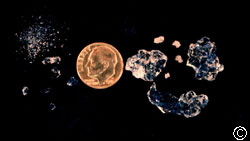Much research has been done on water-absorbing polymers, and the results indicate that they may help save water, but only under certain conditions. Research done at Colorado State University showed little benefit when water-absorbing polymers were used in turf and greenhouse crop production. Petunias in hanging baskets tested in greenhouses showed no benefits when water-absorbing polymers were used. And plants grown in media containing water-absorbing polymers required watering just as often as plants grown in potting soil containing no water-absorbing polymers. The results were the same for turf.
 These polymers do seem to be of some benefit when they’re used in outdoor soil that’s low in organic matter. Some researchers have found that it’s possible to grow several types of plants outdoors with minimal irrigation in soil amended with water-absorbing polymers. The best results are achieved when soil is amended with polymers, and some type of mulch is used to cover the soil.
These polymers do seem to be of some benefit when they’re used in outdoor soil that’s low in organic matter. Some researchers have found that it’s possible to grow several types of plants outdoors with minimal irrigation in soil amended with water-absorbing polymers. The best results are achieved when soil is amended with polymers, and some type of mulch is used to cover the soil.
There are several factors to keep in mind when considering the use of water-absorbing polymers. They can be expensive and must be mixed into the soil uniformly. Also, their usable life is limited by the amounts of salt or fertilizers in the soil. If your soil is already high in salts, your plants probably won’t benefit much from these gels.
Manufacturers claim water-absorbing polymers are able to hold 200 to 400 times their weight in water. The question is, can the plants really use the water held in these polymers? Generally speaking, the expense of buying and incorporating polymers into the soil exceeds the water saved.
For more information, see the following Planttalk Colorado™ script(s).



